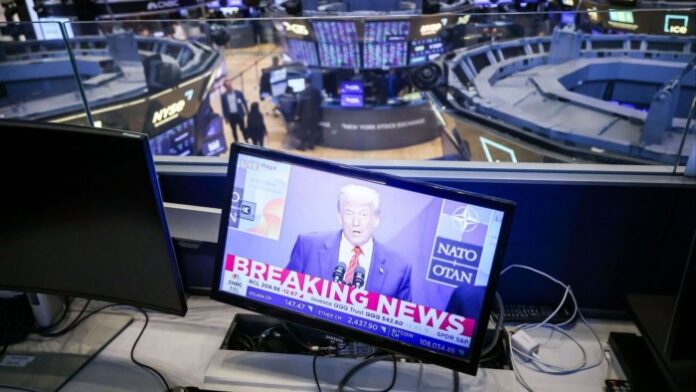Stay informed with free updates
Simply sign up to the US equities myFT Digest — delivered directly to your inbox.
US stocks rose to a fresh closing high on Friday, capping a stunning rebound from a sell-off sparked by Donald Trump’s initial tariff announcements in April.
Wall Street’s S&P 500 ended the session up 0.5 per cent despite the US president halting trade talks with Canada. The index had been up as much as 0.8 per cent earlier, reaching a new record intraday peak for the first time since February.
A US-brokered ceasefire in the conflict between Israel and Iran has boosted equities during the course of the week, easing investors’ concerns about a potential disruption to the flow of oil exports from the Middle East. Trump also said on Thursday the US and China had “signed” a trade truce.
The S&P 500 has risen 27 per cent since hitting a 15-month intraday low on April 7 after the US president announced his “reciprocal tariff” plans several days earlier. The levies unleashed waves of volatility across financial markets, with economists lowering their forecasts for global economic growth.
But Trump’s subsequent delay to some of his tariff plans, along with a series of climbdowns from his more aggressive threats and relatively robust economic data, have spurred a rapid comeback for stocks.
Investors said stocks had also been given a boost this week by the potential scrapping of a provision in Trump’s budget bill that would allow the administration to raise taxes on foreign investments.
“Peak trade uncertainty is in the past, [the US economy] remains resilient and the narrative has re-centred on AI and growth,” said Venu Krishna, head of US equity strategy at Barclays. Citi’s top US equity strategist Scott Chronert expects the S&P 500 to rally a further 2.5 per cent by the end of 2025.
Stocks’ rebound contrasts with continuing pressure on US Treasuries and the dollar — which fell to a three-year low this week — caused by rising concerns about the sustainability of the country’s growing debt.

Measures of US consumer and business sentiment have also been hit by Trump’s erratic tariff announcements on products including metals, semiconductors, cars and basic goods.
But equities have been supported by solid earnings for some of Wall Street’s biggest companies, and signs that Trump’s attempts to radically reorientate US trade policy have yet to reignite inflation or upend the jobs market.
A rush of buybacks and retail investors’ robust demand have provided further fuel to the recent rally. Trump’s landmark tax bill is also forecast by some analysts to boost economic growth and prop up corporate profits.
“Regardless of what actually happens with tariffs, the market seems to view them as old and manageable news,” said Lisa Shalett, chief investment officer at Morgan Stanley Wealth Management.

“The market doesn’t discount the same event twice. There are ‘growth scares’ and we move on.”
Tech stocks slumped early this year but have been the best performers since Trump’s tariff U-turn on April 9. Since that time, shares of analytical software group Palantir are up 69 per cent, online broker Robinhood has risen 144 per cent and server maker Super Micro Computer has gained 50 per cent. “Big Tech led the [earlier] sell-off and is now leading the rebound,” said Krishna.
Industrials stocks have also been big winners in 2025. Howmet Aerospace has gained 69 per cent while Uber and GE Vernova have each rallied more than 50 per cent, putting the three among the best-performing stocks in the sector this year. Defence group RTX and tractor maker Deere have risen by 25 per cent and 23 per cent, respectively.
Yet bearish analysts maintain that the stock market’s gains rest on shaky foundations, warning that slowing growth in bank lending and rising credit card delinquencies point to weakening economic growth.
“While ‘peak pessimism’ may be past, we believe we are far from back to where we were in January,” said Shalett, who said in an email to clients that “in aggregate, the US stock market is even more expensive based on forward earnings” than it was at the start of the year.


